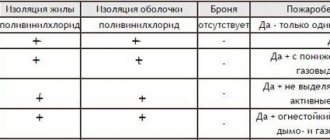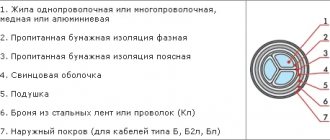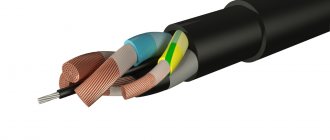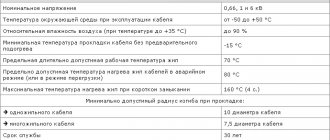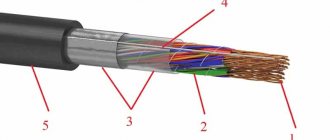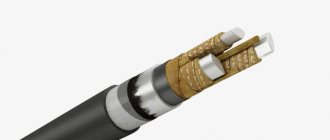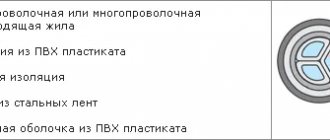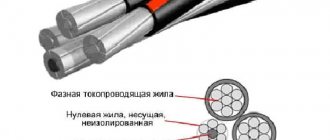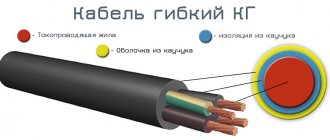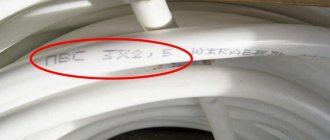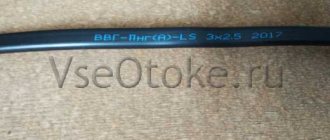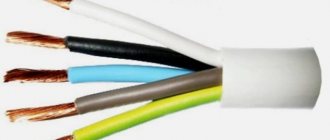For industrial and domestic purposes, NYM cable is increasingly being used to create power and lighting power networks. This is a high-quality German product that comes from Europe and is also produced in Russia. The closest domestic analogue is the VVG cable.
This cable is manufactured using German technologies and is characterized by the presence of copper cores and high-quality plastic insulation that does not support combustion.
Decoding the NYM marking
The marking includes an alphanumeric designation that characterizes the cable parameters.
Consider them in more detail:
- N - indicates that this brand is manufactured in accordance with the German Normenleitung standard;
- Y - indicates the insulation material with which the cable cores are covered, in this case it is polyvinyl chloride or PVC for short;
- M – indicates the presence of an outer sheath in the cable, comes from the German Mantelleitung;
- J – indicates that the cable is equipped with a PE protective grounding conductor with a corresponding yellow-green color;
- O - indicates that the model contains a neutral conductor N with the corresponding blue color.
Consider an example of decoding the markings for the NYM – J – 3 × 2.5 cable. Here is a model with polyvinyl chloride cable insulation, which has a dedicated ground wire. In total, the cable contains three cores with a cross-section of 2.5 mm2 each. The arrangement of all elements inside the NYM cable is determined by its design features.
Load currents for NYM cables
In accordance with the PUE, for any installation method it is recommended that for single cables not exceed the load currents indicated in the table.
| Number of cores | Permissible load current, A | ||
| With two cores | With three cores | With four or five | |
| 1,5 | 19 | 19 | 18 |
| 2,5 | 27 | 25 | 23 |
| 4 | 38 | 35 | 32 |
| 6 | 50 | 42 | 39 |
Design
To better understand the design of the NYM cable, let's look at its design using a specific example.
Rice. 1: NYM cable design
As you can see in the figure, this brand has the following arrangement of elements:
- 1 – current-carrying core, which is made of copper, their number depends on the specific NYM cable model and can vary from 1 to 5 conductors, some factories can find models with 7 conductors. The cross-section of the cores can vary from 1.5 mm2 to 35 mm2, each of the cores is equivalent in size. With a cross-sectional area of up to 10 mm2 inclusive, the core is made as a monolithic conductor. And from 16 mm2 and more it is made of several twisted wires.
- 2 – conductor insulation, made of polyvinyl chloride and characterized by different colors, depending on the purpose of each of the cores. The specific markings for each type are shown in the table below:
Table: color coding of cable cores
| Conductor outer insulation color | Purpose |
| blue | Neutral (N) |
| yellow-green | Protective earth (PE) conductor |
| black, brown, gray | Phase conductors. |
- 3 - sealing layer, made of non-vulcanized chalk-filled rubber, provides additional insulation and prevents the penetration of moisture from the outside. Due to this filler, the NYM cable maintains its round shape and is also not subject to combustion.
- 4 – outer shell, made of sheet plastic and designed to protect against mechanical influences and aggressive substances. Its boundaries determine the total cross-sectional area of the NYM, which depends both on the number of cores and on the size of the insulation on the wires and in the intermediate layer. This parameter affects the possibility of placement in niches, voids, trays, etc. The cross-sectional area of the cable is not always constant, but approximate dimensions can be determined from the table:
Table: geometric parameters of elements of some NYM cables
| Number of cores and cross-section of each | Nominal insulation thickness, mm | Nominal thickness of the intermediate layer, mm | Nominal shell thickness, mm | Nominal cable cross-section, mm2 | |
| Minimum | Maximum | ||||
| 2x1.5 | 0,6 | 0,4 | 1,4 | 8,4 | 9,8 |
| 2x2.5 | 0,7 | 0,4 | 1,4 | 9,8 | 11 |
| 3x1.5 | 0,6 | 0,4 | 1,4 | 8,8 | 10,5 |
| 3x2.5 | 0,7 | 0,4 | 1,4 | 10 | 11,5 |
| 3x4 | 0,8 | 0,4 | 1,4 | 11,5 | 13 |
| 4x1.5 | 0,6 | 0,4 | 1,4 | 9,5 | 11 |
| 4x2.5 | 0,7 | 0,4 | 1,4 | 11 | 12,5 |
| 4x4 | 0,8 | 0,4 | 1,6 | 12,5 | 14,5 |
| 4x6 | 0,8 | 0,6 | 1,6 | 14,5 | 16,5 |
| 5x1.5 | 0,6 | 0,4 | 1,4 | 9,9 | 12 |
| 5x2.5 | 0,7 | 0,4 | 1,4 | 11,5 | 13,5 |
| 5x4 | 0,8 | 0,6 | 1,6 | 14 | 16,5 |
| 5x6 | 0,8 | 0,6 | 1,6 | 15,5 | 18 |
Weight and size parameters of NYM cables
Approximate weights of individual cables for packaging and transportation purposes are given in the table. The given values may differ for NYM cables of different batches and manufacturers by 10% less or more.
| Cable cross-section | Weight value for packaging and transportation purposes, kg/km |
| 2x1.5 | 120 |
| 2x2.5 | 160 |
| 3x1.5 | 140 |
| 3x2.5 | 190 |
| 3x4 | 270 |
| 4x1.5 | 160 |
| 4x2.5 | 230 |
| 4x4 | 350 |
| 4x6 | 500 |
| 5x1.5 | 190 |
| 5x2.5 | 270 |
| 5x4 | 450 |
| 5x6 | 550 |
Specifications
To determine the possibility of using the NYM cable in certain devices, it is necessary to take into account its technical characteristics. These characteristics for NYM are:
- Rated voltage – can be used in electrical networks with a supply voltage of no more than 660 V and a frequency of 50 Hz.
- The rated operating current is determined by the cross-section of the conductor, as is the related parameter - the maximum permissible current that can flow for a short time in emergency situations.
- Temperature limits - the temperature value at which NYM can normally perform its functions without loss of specified parameters and destruction of any elements. For NYM cable the limit is from – 50ºС to + 50ºС.
- Core resistance is set individually for each specific cable and determines its throughput or permissible amperage.
- Insulation resistance - determines the dielectric properties of the insulating layer, both between conductors and from each conductor to conductive elements that may touch the outer sheath.
- Bending radius should not exceed 4 outer diameters of the cable itself.
Rice. 2: permissible cable bending radius
Conditions for installation and operation of NYM cables
The DIN VDE 0250-204-2000 standard does not specify the ambient temperature during operation, but the temperature is determined by the parameters of the PVC plastic for insulation and sheathing and can range from -15°C to a temperature at which the heating of the cores does not exceed +70°C. It is recommended to lay the cable with a bending radius of at least 4 outer diameters of the cable. Does not propagate combustion when laid alone. Not intended for use under direct sunlight. The service life of NYM cables is not regulated.
Advantages and disadvantages
Compared to other cable and wire products available on the domestic market, NYM cable has a number of significant advantages:
- Not afraid of moisture - in comparison with domestic models with vinyl insulation, NYM is much less susceptible to moisture absorption. Due to this, NYM can also be laid in wet areas (basements, wells, mines, etc.) without additional devices.
- Flexibility - easily changes geometric shape and can be laid in the most difficult to reach places, make turns, etc. This property is ensured by the intermediate layer.
- Does not support combustion - due to the composition of the intermediate layer, the insulation does not burn, but only melts when exposed to a flame or spark. This property allows NYM to be used in areas with increased fire hazard.
- It has a wide variety of design options , both in the number of cores and in their cross-section, due to which one such cable can provide full power supply in circuits with a different number of phases, wires and for any load.
It should be noted that an important factor in all the advantages of the NYM cable is the manufacturers’ compliance with the international standard. Which ensures higher quality products in all respects.
But, in addition to the above advantages, NYM also has some disadvantages. Firstly, the high quality of all NYM brand cables also determines their higher cost in comparison with domestic analogues, for example, the same VVGng. Secondly, NYM is not recommended for installation in areas where it may be exposed to sunlight. Since its insulation loses its characteristics from the sun, and the cable fails much faster.
Available methods for quality control of NYM cables
Control methods are presented that, while not strictly complying with the DIN standard, allow making preliminary conclusions about the quality of the cable if the measured values differ significantly from the regulated ones. The final conclusion about the compliance of the cable with the standard can be made only after testing the cable in a specialized laboratory using strict methods and in the volumes specified in the standard.
Visual inspection The following can be checked: the number and color of the cores, the number of wires in the core, the integrity of the insulation, filling and sheath and the ease (without damage) of their separation.
Measurement of structural dimensions Can be checked using suitable measuring instruments: insulation thickness, infill and shell walls, and outer diameter. Measuring the diameter of the wires dpr and calculating the cross-section of the core using the formula 0.785dpr2N (where N is the number of wires in the core) is not a strict method for controlling the cross-section of the cores, because confirmation of cross-section compliance is electrical resistance, however, a significant deviation of the calculated cross-section from the nominal (more than 10%) may serve as a basis for doubts about the quality.
Measurement of the electrical resistance of current-carrying conductors Can be carried out on a finished cable with an ohmmeter with a suitable measurement limit (for cables with a small cross-section at a normal length in a coil or on a drum, it can be several Ohms) and recalculated for a length of 1 km. If the cable has twisted cores, the obtained values should be reduced by 1.02 times. Particular attention should be paid to making good contact with the test leads.
Application
NYM cable is used as a device for transmitting electrical energy in power circuits. This brand has become widespread in the power supply of both household and industrial facilities. Due to its varied design, it can be installed for single-phase and three-phase circuits, both with and without a dedicated grounding or neutral conductor.
Rice. 3. NYM application for single-phase and three-phase consumers
NYM is used for the manufacture of wiring, both internal and external. In the first case, laying in the walls is carried out in a standard way without the need to use additional devices. External fastening is also carried out on open sections of walls, but unlike other brands of cable and wire products, it does not require additional protection and insulation using the same cable channels, corrugations, etc., since the number of dielectric layers already provides a sufficient level isolation. Exceptions for outdoor installation are walls made of flammable material and those areas where NYM is exposed to direct sunlight and must be protected from ultraviolet radiation.
NYM cable is also used to connect powerful equipment and power units. For this, both two-wire and more branched options are selected, depending on the type of load. As an example, it can be used to make an extension cord to power a power tool during construction work. Since the NYM insulation level is more than enough for any class of power tool.
It can be installed as a current-carrying element in fire and explosion hazardous areas of any objects. Where installation of other types of cable and wire products is not permitted.
Cable structure
In fact, the model for German-made nym brand wire was the domestic VVG cable. German specialists eliminated some of the shortcomings that affected the quality.
Additional Information. In the electrical conductor market you can find variations of the spelling of this type of wire, such as num or nyum.
The very name of this electrical product means the following:
- “N“ - cable products meet the Normenleitung standards of the German Association of Electrical Engineers, which is why NUM wires are equipped with a certificate of compliance with international quality requirements. This power cable is suitable for use in places with a high level of fire hazard (the designation “VDE” is placed on the outer layer of the cable);
- “Y” – the use of thermoplastic vinyl chloride polymer for the insulating layer;
- “M” – variety of conditions for using the product.
The internal structure of the num type wire consists of:
- Cores made from industrial copper: can be composed of either one or several wires, which is determined by the given cross-section of the wire;
- Each current-carrying core is covered with an insulating sheath made of PVC plastic;
- The outer layer of insulation is also made of polyvinyl chloride;
- The gaps between the cores and the outer layer are filled with sealant made from an unvulcanized chalk-filled rubber (rubber) mixture. This is done so that when cutting the cable, the cores can be easily separated from the sheath by cutting and breaking off.
The outer PVC sheath is usually light gray in color. The number of cores can vary from 1 to 7; they have the same cross-sectional area, but different color markings that comply with world rules: for phase conductors - any colors except yellow, green and yellow-green, which are used for grounding wires.
nym cable core colors
The cross section of each vein is from 1.5 square meters. mm up to 0.35 sq. cm. If the cross-sectional area of the wire is less than 10 square meters. mm, they are made monolithic, from 0.16 sq. cm - only twisted.
Depending on the presence of a grounding conductor, NUM wires have two varieties, which is reflected in their names. Thus, the prefix j is added to the nym brand if the number of cores in the wire exceeds three and the grounding wire is among them. In the arrangement there are two cores, but without “ground”, and with a zero core (blue marking) the cable receives the name NYM-O.
Difference between nym-o and nym-j cables
Main manufacturers
It should be noted that the distinctive quality of the NYM cable is ensured by an international standard, which is characteristic not only of German brands, but also of a number of domestic manufacturers. Of course, domestic samples are no worse, but have a more affordable price. Among domestic ones it is worth highlighting:
- "Sevkabel";
- "Concord";
- "Kamkabel";
- "Pskovkabel".
Among foreign manufacturers who have the appropriate certificates and supply their products to the domestic market, the following should be highlighted:
- Serbian "Novkabel AD"
- German “Lapp Kabel”, “Kabeltec”, “TKD Kabel”;
- French "Nexans";
- Turkish "DENIZLI CABLE LTD".
By purchasing NYM cable from these companies, you can be sure that it meets the stated parameters. If you come across a model from other manufacturers, then to identify a fake, pay attention to the markings. Companies that do not meet the standard try in every possible way to rename their products to the similar name NUM or HUM instead of NYM. This can be seen on the shell:
Rice. 4: Example of non-original markings
As you can see in the picture, the top cable has the original markings, but the other two differ from it. Therefore, it is impossible to guarantee the same technical characteristics for them.
Briefly about the main thing
The technical characteristics of the NYM cable practically do not limit the scope of its application, subject to the correct selection of the cross-section and protective sheath, if used outdoors. Domestic products, "Kamkabel" and "Pskovkabel", are at least not inferior to foreign analogues in terms of conductive characteristics, but may be inferior in quality of protective coating - if this parameter is important, then it is better to choose a cable made in Germany, Turkey or France, despite the difference in price.
Design features
VVGng is a power cable with copper conductors. The core insulation is made of polyvinyl chloride plastic. The insulation material contains additives that make it flame retardant. This conductor is available with a number of cores from 2 to 5. For ease of installation, the core insulation is color-coded, which can be done by completely painting the core insulation, or with a colored stripe. The outside of the cable is covered with a sheath made of the same PVC plastic as the core insulation. The core can have a single-wire or multi-wire design. The cross-sectional shape of the core can be round or segmented.
NYM is the designation of an analogue of the Russian product brand VVGng, produced according to the German standard VDE 0250. The number of cores also varies from 2 to 5. The insulation material is the same polyvinyl chloride, which does not support combustion. The main design difference between this product and its Russian counterpart is the presence of an additional non-flammable seal between the core insulation and the outer sheath of the cable.
Description and transcript
NUM wire is a cable product that is widely used for lighting and household purposes, as well as stationary power, where the voltage is no more than 0.66 kV at frequencies of approximately 50 Hz.
Installation of an electrical product is possible inside dry and damp rooms, in a humid environment and in open space, but only with strict adherence to the required level of protection from ultraviolet radiation and mechanical impact. For safe operation, corrugated pipes, metal hoses and cable channels are used. It is not prohibited to hide power cables under layers of plaster or lay them on top of it, in concrete or brickwork.
It is prohibited to press NUM type power wire into vibro-filled or stamped concrete.
Explanation of the NYM marking:
- N – belonging to the Normenleitung cable product classification, quality meets German standards.
- Y - insulation material used in production - polyvinyl chloride or PVC plastic.
- M – installation possible in different conditions.
The insulating surface must additionally bear the VDE marking, which indicates that a particular product is manufactured in accordance with the German industry standards Veiband Deutscher Electrotechniker 0250 and can be used in areas with an increased risk of emergency situations.
